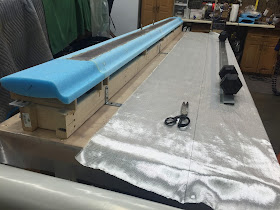Skinning the bottom (17.7 hrs)
Honestly, the difficulty rating for this section of the canard has to rank pretty low, as long as one doesn't take into account the amount of time spent on one’s feet. Even with the shop stereo blasting 70’s Disco music into the wee hours of the night, and the impromptu dance move to keep from developing wear patterns in the joints, the aftermath of 11 hours of glassing looked like the scene of a head on collision, with my right knee being the principal casualty, and my lower back a close second.
Personal problems aside, let’s reconstruct the chain of events that lead to so much discomfort.
 |
| The EZ shop ready for action |
Before getting to the sticky end of things though, a little prep was in order, namely adding peel ply to the entire length of trailing edge of the canard.
This will provide a crisp, micro free, and ready to bond section once the canard is flipped over, the foam "fishtail" sawed off the trailing edge, and the peel-ply removed.
 |
| Marking a 1/2" (1.3 cm) reference line from the trailing edge |
 |
| I decided to use these heavy duty staples (no I didn't use the stapler). |
 |
| I pushed the staples in by hand every foot (30 cm) or so |
I don’t really enjoy using micro to fill gaps in the foam next to a structural member, such as the spar-cap. I mostly worry about contaminating the structural glass-glass bond of the skin with stray micro. For that reason, although heavier, I have occasionally used flox in the past.
This time I thought that with “special handling” I might be able to pull off a clean (as in free of micro) structural bond between the spar-cap and the bottom skin, thus taking advantage of the weight saving properties of micro over flox.
To accomplish that, I pre-deployed duct tape all over the spar-cap, then went to work with the dry micro, filling all the big dents and cracks.
 |
| Dry-micro filling every crack and low spot |
This worked better than I expected, and with another item off my checklist I moved on to spreading micro-slurry over the remaining foam in preparation for skinning.
 |
| Nothing fancy, but sometimes a list helps keeping things moving. |
 |
| 1.5 hours of micro-slurrying |
The good news about using tape this way is that it left a perfectly preserved micro-free zone over the spar-cap, with super crisp edges. Truly a thing of beauty.
The bad new is that since I had left this duct tape in position for a couple of weeks, it did not peel cleanly off, and left pieces of adhesive in many places. These were a real pain to get off, especially when trying to maneuver around the surrounding freshly microed areas.
 |
| Tape and adhesive removed from the spar-cap |
The layup for this section is made up of 1 UNI layer full span, 1 BID layer (at the usual 45º bias) made up of 4 pieces, and 1 additional full size UNI layer.
I began the layup by painting the spar-cap with pure epoxy, and getting the previously cut fiberglass off the shelf.
 |
| Cutting UNI about 13" (33 cm) wide |
 |
| 13" wide BID strips getting cut at 45º |
 |
| Wetting the spar-cap with pure epoxy |
 |
| After 3 hours of work, I am just getting ready to start fiberglassing. |
Obviously, both the UNI and the BID needed to be cut slightly in a couple of spots to clear the metal lift tabs (CLT), other than that, this job turned out to be mostly an exercise in straightening fiberglass weave.
 |
| After much fiber straightening, the first UNI cloth is being saturated with pure epoxy. |
 |
| First UNI layer work is completed |
 |
| Note the two slits cut into the fiberglass that allow the two lift tabs to poke through |
 |
| Starting with the first BID piece of layer #2 |
Uncharacteristically, the BID is butted together here, not overlapped, in order to minimize the bump of the joint line on the aerodynamically sensitive surface.
 |
A second piece of BID covers the extremity
|
 |
| Right side of layer #2 done |
 |
| Same thing viewed from the far end |
 |
| Working on the opposite side now with BID pieces 3 and 4 |
 |
| Layer #2 completed |
 |
| Middle section of the canard, where the BID actually overlaps. |
 |
| Final layer of UNI |
 |
| Layer #3 after been slit where the lift tabs protrude |
 |
| Unfortunately I still produced an undesired, though faint, "bump line". |
 |
| I peel-plied the faint 45º "bump lines" in order to further minimize their prominence |
After surviving the painful night, I staggered back into the shop, and with the help of my faithful “assistant”, cleaned up the usual loose ends.
 |
| Ripping the peel-ply from the leading edge of the canard. The top skin will overlap here. |
 |
Rough cutting of the trailing edge overhang
|
 |
| Scoring the leading edge |
 |
| Removing fiberglass and red tape from the leading edge |



































No comments:
Post a Comment